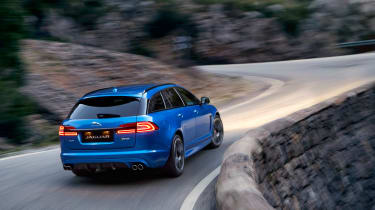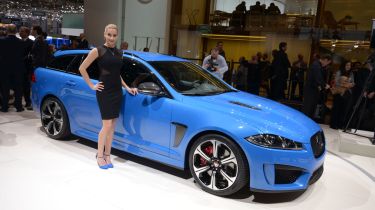Jaguar XFR-S Sportbrake 2014 review
New Jaguar XFR-S Sportbrake takes on Mercedes E63 AMG Estate for charged-up estate crown

It’s taken some time for the Jaguar XFR-S Sportbrake to appear. It's set to rival the Mercedes E63 AMG Estate and Audi RS6 Avant, and it does - and more. This isn’t just an attempt to get on to a level playing field. While the XFR-S Sportbrake can feel a little too lively for its own good at time, that doesn’t take away the fact that this is an involving and excellent fast estate that should the fight to its rivals.
Fast estates are an attractive proposition. Not only do they retain the practical prowess to cope with all the demands of family life, they also help feed the urge of adding some excitement and involvement to matters. And the Jaguar XFR-S Sportbrake is the latest to join the growing list of options.
It’s taken two years for Jaguar to give its most practical model the hot treatment, and rather than show a natural progression through an XFR version upwards (which it did with the Saloon model) the manufacturer has gone straight to the most extreme point.
The car, driven here in prototype form, gets the same engine as the XFR-S Saloon in the form of the 542bhp 5.0-litre supercharged V8. That’s enough to propel the Sportbrake version from 0-62mph in just 4.8 seconds. And it’s hardly subtle in delivering that power.
Used - available now

2020 Mercedes
E-Class Coupe
47,266 milesAutomaticDiesel2.0L
Cash £17,463
2021 Renault
Arkana
43,611 milesAutomaticPetrol1.6L
Cash £15,087
2025 Toyota
Yaris Hybrid
19,964 milesAutomaticPetrol1.5L
Cash £16,000
2022 Kia
Sorento
24,049 milesAutomaticPetrol1.6L
Cash £30,700The slightest touch of the accelerator pedal and the engine roars in to life. In fact give it too much too quickly and the rear-wheel drive Sportbrake feels a real handful, and you’ll need to be at your most alert to keep things in check. Be a little more careful, though, or opt for winter mode on the car’s drive mode function, and the power delivery is more linear and controllable.

To help cope with the power in an estate body, ride stiffness is up by 30 per cent over the standard model. And thanks to this, along with the larger brakes, wider tyres and electronic diff, the car feels enjoyable out on the road, though our brief drive didn’t allow us to test it to its full limitations.
The stiffer settings doesn’t seemed to have ruined things on the comfort front, however, and while the majority of our short test was on mostly smooth roads, it didn’t become unbearable on the small bits of broken surfaces we did encounter. Yes, it is firm, but didn’t feel like it would leave you wanting to avoid all but the smoothest of roads.
The eight-speed gearbox is the same used in the Jagaur F-Type. The changes are smooth and incredibly quick, while in Sport or manual mode the system automatically blips the throttle. It also has Corner Recognition, though we didn’t get to try it first hand, which recognises when you’re in a bend and will hold on to gears for longer rather than changing up and losing any speed.
Aesthetically, the Sportbrake mirrors the XFR-S saloon with a deeper front bumper that house larger side and central air intakes. There’s also an extended rear bumper and six-spoke 20-inch alloys, to help give it a more menacing look over the standard car.
Underneath all this bravado is still a practical family car with 550 litres of boot space. And while it may have taken Jaguar some time to give its Sportbrake the performance makeover, it feels as though it was well worth the wait.







